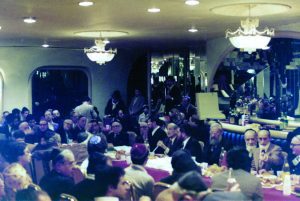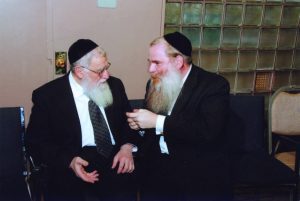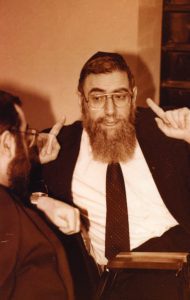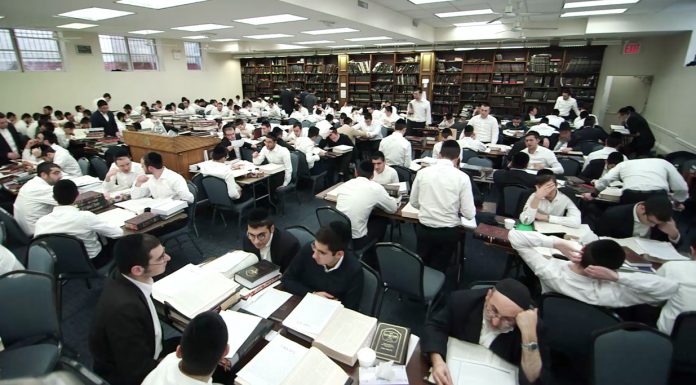RABBI BINYOMIN ZEV KARMAN
Everyone loves a good story with a happy ending, especially if there is a little tension and resolved uncertainty. Here is part of our community’s history that will make some nostalgic, and will open others’ eyes to the breaking history that began back in the 1970s. Like much of Jewish history, our real stories are even better than fiction!
“I am not the type of Rabbi that your congregation wants,” was the Rabbi’s adamant response. The group awaiting the Rabbi’s answer was taken aback. Although he had been part of Young Shaarei Zion for the past decade, the Rabbi had just announced that he was heading back to Israel, dashing their hopes and aspirations.
Shaarei Zion is home to several minyanim each Shabbat. The Dome, as the main sanctuary is commonly called, is located on the ground floor of the building and seats 400 congregants, while Young Shaarei Zion was situated on the lower level in the social hall. Hacham Baruch, zt”l, officiated frequently at the Shabbat morning prayers, and Hacham Yosef Harari Raful led the minyan for the Yamim Nora’im and other times when Hacham Baruch was upstairs in The Dome.
Hacham Yosef Drops a Bombshell
In the summer of 1975, Hacham Yosef suddenly announced that he was ending his career in New York and was returning to Israel. He had set down roots in the Syrian community of Brooklyn, where he taught in a local high school and delivered a class on Shabbat afternoon, and his wife’s family, the Dayans, were prominent leaders in the neighborhood. Nevertheless, Hacham Yosef felt he was not accomplishing what he had set out to do, and he was determined to begin anew in Eretz Yisrael.
The announcement came as a surprise. Ezra Raful, Hacham Yosef’s son, was away in camp for the summer when he was told that he had to return home two weeks early because the family was moving to Israel. “I remember how disappointed he was,” says his cousin Rabbi Aharon Raful. “We were enjoying an exciting summer together, and suddenly he had to go home.” Back in Brooklyn, Ezra would cry on the stairs in front of his house, bemoaning his fate.
A Bold Request and a Bold Answer
Hacham Baruch notified his congregants that he was needed each week in The Dome and would no longer be able to join them Shabbat morning. At a seudat preidah for Harav Raful, the congregants decided to try one last time to convince him not to abandon them. “In hindsight, we were quite bold making such a request,” says Ezra Erani, one of the congregants who attended that goodbye party. “The Rabbi was all packed and ready to board the plane, and here we were, asking him to change his plans. Rabbi Raful did not seem interested in our proposal and basically rejected it out of hand. But as we persevered, he looked us in the eye and set down some difficult tena’im, conditions, under which he would reconsider.”

“If I am to stay, you must agree to accept my word as law, whatever it may be,” Hacham Yosef said forcefully. “You can decide what danishes to provide,” he quipped, “but everything else must be my decision, and you must abide by it. If you are ready to commit to that, I am ready to remain and serve you b’lev u’vanefesh, with my heart and soul.” After considering it overnight, the members of Young Shaarei Zion agreed, and they now had a new Rabbi and a watershed moment.

Whirlwind Changes
Changes followed almost immediately. “We cannot have a successful kehillah without a daily minyan,” Hacham Yosef said. Although the members felt it was impractical, they had given their word and they organized it. Two weeks later, another directive was given. “We must have a shiur before Shaharit,” he said. “We will quicken the pace of the prayers and spend 20 minutes learning.” This was in line with the passuk in Mishlei (28:9) that states, “One who turns away his ear from hearing Torah, his prayers are also an abomination.” The surprises did not end. “We will be learning gemara, starting with Masechet Berachot,” he said, overruling their protests that perhaps Chumash or halachah may be more appropriate. “My mission is to burn out the am haaratzut from the community. You are all capable of becoming talmidei chachamim, and we will reach this goal together!”
The early morning class began with just seven people. Shortly afterward, Hacham Yosef added a Wednesday evening class in which he taught another perek of the masechta. He would read, translate, and explain each word, patiently guiding his students on their path to becoming proficient. The shiur included active participation, where each member of the class got involved in the give-and-take of the learning. Before long, they were learning not just Rashi and Tosafot, but adding Rishonim such as the Rif, Rabbeinu Yonah, and the Rambam as well. The 20-minute shiur now spanned an hour, as the participants longed to absorb as much as they could.
After a year and a half, the shiur completed the entire Masechet Berachot. Rabbi Raful insisted they make it a communal celebration. “We had a gala meal with music and dancing, and all the Rabbanim and dignitaries of the community came,” Ezra Erani recalls. “They had never experienced such a joyous occasion, and neither had we. It made a tremendous impact, and as we began Masechet Shabbat, more classes led by more Rabbanim were added.” Harav Asher Hachuel, shlita, taught a class for beginners, which attracted an ever-growing group of newcomers.
Limud Torah Surges – Not Only for the Men
When Hacham Yosef felt the kehillah was ready for another innovation, he introduced Torah learning to the Shabbat morning minyan. His students, who were growing by leaps and bounds, were to become the teachers for the rest of the congregants as they learned hilchot tefillah. During the week, Hacham Yosef would make sure they knew the material, and after kriat haTorah, they would break up into small groups and teach the halachot to the others. Success breeds success, and before long the members began coming in to learn on Shabbat afternoon as well to increase their limud haTorah.
While Hacham Yosef was pleased with the growth in Torah of the men, he knew that this revolution must include the women of the community as well. Sparing no effort, he retained Rebbetzin Zahava Braunstein, a”h, to deliver classes for the women, and she became their role model. She taught a class every Monday night in Congregation Bnei Yosef, while Rabbi Raful taught the men in another room.
As the new minyan expanded to include 20 families and continued to attract new ones, they moved to new quarters, eventually renting their own building. The small group was now its own kehillah, and Hacham Yosef knew it was time to take it to a new level. True, learning Torah every morning and on Shabbat was impressive, but his goal was to create a kehillah of talmidei chachamim. The time was ripe to open a kollel, which would lay the groundwork for the crowning glory of their new community: the founding of Yeshiva Ateret Torah.
Enter Rabbi Chaim Aharon Weinberg

In preparation for its opening, Rabbi Raful searched for the right mechanech to lead the school. He zeroed in on Rabbi Chaim Aharon Weinberg, zt”l, a talmid of Yeshivas Telshe who was embarking on his career in chinuch. As a Vizhnitzer Chassid, Rabbi Weinberg would not make such a move without the consent of his Rebbe, and Rabbi Raful went along with him to Monsey to discuss his plans with Harav Mordechai Hager, the Vizhnitzer Rebbe of Monsey, zy”a. After hearing his plans and seeing his devotion, the Rebbe advised Rabbi Weinberg to accept the job and gave his berachah. Yeshiva Ateret Torah was now a reality.
In September 1980, the yeshiva opened with a pre-1A class of 22 boys, with Rabbi Weinberg serving as the Rebbi and Menahel. Nothing was beyond his purview as he provided the families with transportation, lunches, and of course a large dose of caring as the youngsters began their ascent. In 1982, Bet Yaakov Ateret Torah opened for the girls of the community. When the high school opened in September 1990, Rebbetzin Braunstein, who had taught the mothers of the girls for many years, became its principal. The administration sought the best Rebbeim and teachers, and the students performed beyond expectation.
Yeshiva Ateret Torah and Affiliated Institutions Find Permanent Homes
The school and the minyan were outgrowing their quarters, and a search began for a lot on which to build a permanent home for Yeshiva Ateret Torah. When a large parcel on Quentin Road and East 9th Street was put on the market, they hurried to put a down payment on it, generously provided by the philanthropist Mr. Ellis Safdeye, a”h. The deal was sealed, and plans were drawn to construct the building. Construction began in 1985 and was completed prior to the 1986-1987 school year. Bet Yaakov Ateret Torah occupied several locations, finally settling into their new campus on Coney Island Avenue in 2006.
Metivta Ateret Torah opened its doors in September 1989, and the Bet Medrash started in 1993. In order to maximize their growth, the metivta joined Camp Morris, the summer home of Yeshivas and Mesivta Rabbeinu Chaim Berlin, where the talmidim had the opportunity to spend the summer months immersed in an atmosphere of Torah among bnei Torah. Eventually, several families of the Ateret
Torah community decided to spend their summers at Camp Morris, which prides itself as the host for these serious bnei Torah.
Appreciating the Transformation
The Ateret Torah community is flourishing, and its success has influenced the associated Syrian shuls to undertake similar upgrades in their programs. “Although I have been a member of Ateret Torah for 45 years, and I haven’t prayed in Shaarei Zion for some 30 years, I recently had an early morning meeting which brought me to Shaarei Zion one morning for Shacharit, and I couldn’t believe my eyes!” admits Ezra Erani. “Upstairs, downstairs, wherever you looked, there were people sitting and learning Torah before Shacharit. There wasn’t an empty seat to be found! If you enter Shaarei Zion in the evening, you will find hundreds of children participating in the ‘Bring a Buddy’ program, where young boys sit and learn Torah with a havruta. There are tables set up throughout the building, which is filled to capacity. And to think that when this all began, no one but Hacham Yosef believed that the community was capable of becoming lomdei Torah on a high level!”
In order to truly understand the transformation that took place, one must look back at the belief that was commonly held, even by those who championed the Syrian community a half century ago, that the Syrian community was not ripe for strict observance of Torah law and the creation of a core of talmidei chachamim.
Mr. Isaac Shalom was one of the laymen who worked tirelessly to build institutions for the Syrian community in Brooklyn and almost single-handedly created Magen David Yeshivah, the flagship school, which today boasts over 2,000 students. In 1945, when he became aware of the downward spiral of the Sephardic communities in Morocco, Egypt, and other Middle Eastern lands, he recruited Harav Avraham Kalmanowitz, zt”l, the Rosh Yeshiva of the Mirrer Yeshiva, to travel to these countries and organize schools for the children.
Yet when Hacham Yosef discussed the prospect of raising the level of Torah scholarship in the Syrian community in Brooklyn, Mr. Shalom was pessimistic. “In a business-oriented community like ours,” he said, “I don’t think we can cultivate talmidei chachamim. We should look to Eretz Yisrael to provide us with Rabbis and teachers for our institutions.”
Even Harav Kalmanowitz, who worked tirelessly to provide authentic Torah education for the children and young prospects of the Sephardic communities in the Middle East, was doubtful that Rabbi Raful’s mission would succeed, despite his own burning desire to spread Torah worldwide.
Hacham Yosef’s Determination Bears Fruit
Yet, Hacham Yosef was not deterred. He was convinced that Hashem would never abandon His nation and believed the potential existed for every one of his community members to become a talmid hacham.
“If we do our own mesirut nefesh and we work l’shem Shamayim, Hashem will give us the siyatta diShmaya to raise generations of our own bnei Torah. We can do it,” he believed. “I am certain we can.”
Today, 46 years after that fateful day when the members of Young Shaarei Zion agreed to the conditions set down by Hacham Yosef Harari Raful, zt’l, his dream has come to fruition. The positions of Rabbanim, melamdim, and other klei kodesh of the Ateret Torah community are filled with graduates of Yeshiva Ateret Torah.
Adapted from an article that originally appeared in The Inyan – The Hamodia Weekly Magazine.
Photos – courtesy of Hamodia.



